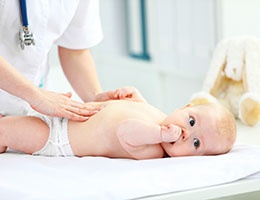 Infants and children with acute abdominal pain present to emergency departments, urgent care centers and physician offices with a variety of signs and symptoms. Since infants can’t localize pain and pre-school children are often imprecise in their responses, the healthcare practitioner may find it difficult to ascertain the actual dilemma.
Infants and children with acute abdominal pain present to emergency departments, urgent care centers and physician offices with a variety of signs and symptoms. Since infants can’t localize pain and pre-school children are often imprecise in their responses, the healthcare practitioner may find it difficult to ascertain the actual dilemma.
The exact time course of the illness is often unclear due to a change in caretakers through the child’s day. For example, the child may have been with Mom in the early morning, a schoolteacher in the late morning, and a babysitter in the early afternoon. Finally, some illnesses manifest differently in the various age groups and can be very subtle on initial presentation.
These factors combine to increase the difficulty in making an accurate and early diagnosis in infants and children with acute abdominal emergencies. This blog will highlight pediatric abdominal conditions that have serious risk and safety implications for the clinician and the patient.
Malrotation with Midgut Volvulus
Malrotation occurs in only 1 of 500 live births. It is a consequence of incomplete rotation and fixation of the intestine during fetal development during the first trimester. Midgut volvulus occurs in just 45%-80% of those patients based on various studies. Up to 80% of malrotation presents within the first month, and up to 90% of patients are diagnosed by one year of age. This condition may present in older children and adults as well.
A failure or delay in diagnosis may result in significant morbidity or mortality. Symptoms can occur suddenly, with bilious emesis as an ominous initial sign. Spontaneously resolved episodes of bilious vomiting might have occurred before presentation; this might be the only clue the clinician obtains from the history.
Physical exams can be normal in 50%-60% of infants in the early stages of volvulus. Abdominal distention is usually not present since the obstruction is more proximal in the abdomen. Only about one-third of infants with distention will have concomitant tenderness. This should not dissuade the physician from pursuing the matter aggressively.
Plain X-rays CANNOT exclude the diagnosis of volvulus. A limited upper GI series will be definitive and should be obtained emergently whenever the practitioner entertains the diagnosis of volvulus. Ultrasound may be helpful, but like plain X-rays, it CANNOT be used to exclude the diagnosis of volvulus. Laboratory data yields no diagnostic value.
Hypertrophic Pyloric Stenosis
- Usually occurs from 2 to 12 weeks, but can arise as late as 20 weeks.
- Males predominate with HPS at a 4:1 incidence.
- The overall incidence is 2 to 4 per 1,000 live births in Caucasians, but much less in African-Americans, and rare in Asians.
- Bottle-fed infants have a higher rate than breastfed babies.
- Those with blood type B or O are affected more.
 Vomiting is a premier symptom and is non-bilious, but it can become blood-tinged due to gastritis. The classic “olive” of the hypertrophied pyloric muscle is infrequently palpated. Definitive diagnosis by ultrasonography is 99.5% sensitive and 100% specific with experienced technicians. Before the advent and wide use of ultrasound, an upper GI series was the standard of care for imaging.
Vomiting is a premier symptom and is non-bilious, but it can become blood-tinged due to gastritis. The classic “olive” of the hypertrophied pyloric muscle is infrequently palpated. Definitive diagnosis by ultrasonography is 99.5% sensitive and 100% specific with experienced technicians. Before the advent and wide use of ultrasound, an upper GI series was the standard of care for imaging.
Intussusception
Although intussusception in a pediatric patient is not very common, an otherwise healthy child can experience this condition without warning and without any known etiology. It is the second leading cause of an infant’s intestinal obstruction behind incarcerated inguinal hernias. It can occur from ages 3 months to 6 years, but the peak incidence is from 6-12 months. Most occur before age two years, although 10%-25% occur after this age.
- At the onset, part of the bowel will invaginate itself into a more distal portion of the bowel in a wave-like fashion (think of how a telescope collapses on itself when closing).
- This will eventually cause intestinal obstruction with local ischemia and necrosis.
- It is important to be aware that the child may have a normal exam initially, as no external signs will be seen or felt.
- Subsequently, the child will vomit, become lethargic, and progress to a shock-like state.
- Fever and currant jelly/blood stools are late findings.
Ultrasound is used to confirm the diagnosis of intussusception, and an air-contrast enema will not only diagnose the condition, but successfully reduce it.
Appendicitis
Unlike the relatively uncommon midgut volvulus and hypertrophic pyloric stenosis, acute appendicitis affects 1%-8% of all children presenting to EDs and physician offices with a complaint of abdominal pain. The lifetime incidence is 7%-9%, with males 2% higher than females. It is the leading abdominal problem requiring surgery in childhood.
Vague abdominal pain followed by nausea, vomiting and pain migration to the right lower quadrant is the “typical” story in older children and adolescents. Kids under 5 years may just have pain with vomiting, fever and anorexia. Abdominal distention, irritability, right hip pain, and limp can be encountered in children less than 2 years of age. The presence of diarrhea should not dissuade the practitioner from pursuing the diagnosis, as it can be present a reported 10%-40% of the time. Anorexia is not universal and may only be present 45%-75% of the time.
Physical exam findings such as rebound tenderness may suggest appendicitis, but they are not diagnostic of appendicitis. The combination of leukocytosis and an elevated C-reactive protein correlate with the presence of appendicitis, but also are not 100% specific or sensitive. Beware the urinalysis with pyuria or hematuria in the patient with abdominal pain, as appendicitis can irritate the ureter or bladder resulting in the urinalysis mimicking a UTI! Graded-compression ultrasound is the initial imaging modality of choice in children, followed by CT if the ultrasound is equivocal.
The child with abdominal pain deserves special attention. This patient population presents a unique series of clinical entities and diagnostic challenges. It is imperative that any practitioner managing pediatric patients on a regular basis has an awareness of the unique aspects of abdominal pain in the pediatric population.
Pediatric abdominal emergencies are covered more extensively in this online course for CME.


